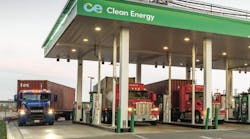National average retail pump prices for both diesel and gasoline continued falling this week, according to data tracked by the Energy Information Administration (EIA), mirroring price declines for both fuels on a regional basis across the U.S.
Diesel dropped 3.1 cents to a national average of $2.348 per gallon, the agency said, which is 32 cents per gallon cheaper compared to the same week in 2015.
Prices for diesel declined in every region of the country as well, EIA pointed out, with the biggest declines occurring in:
- The West Coast (when not including California): down 4.4 cents to $2.492 per gallon. With California’s prices included, that changes to a 3.3 cent decline to $2.63.
- The Central Atlantic: down 4 cents to $2.441.
- New England: down 3.8 cents to $2.396.
- The Midwest: down 3.7 cents to $2.304.
Gasoline fell as well this week, dipping 2.3 cents to a national average of $2.159 per gallon, which is 53 cents per gallon cheaper compared to the same week last year.
Prices for gasoline declined across the board on a regional basis in the U.S. as well this week, EIA said, with the biggest declines occurring in:
- The West Coast (when including California’s prices): down 5.6 cents to $2.614 per gallon. When not including California, prices on the West Coast dropped 3.8 cents to $2.421 this week.
- New England: down 4.1 cents to $2.168.
- The Gulf Coast: down 3.6 cents to $1.944 per gallon.
EIA also emphasized that gasoline prices may enjoy further declines in the near future.
The agency said the U.S. gasoline front-month futures crack spread has declined in recent months due to increased U.S. gasoline production and inventories. In June, the reformulated “blend stock” for oxygenate blending (RBOB)-Brent crack spread hit 37 cents per gallon, which is 18 cents per gallon below the June 2015 level and slightly lower than the five-year average.
The recent trend of declining gasoline crack spreads extends beyond the U.S., as unlike in 2015 when gasoline crack spreads in some regions worldwide rose to match or set new recent record highs, spreads in 2016 are now significantly below last year’s levels and are generally closer to their respective five-year averages.
For although gasoline consumption is “robust” in countries such as the U.S., China, and India, EIA stressed that gasoline crack spreads reflect supply conditions – and growth in gasoline supply has exceeded the increase in gasoline consumption since last summer.
Refineries in the U.S., Europe, and Asia all increased production of gasoline compared with distillate to take advantage of the high gasoline crack spreads that occurred back in 2015 and in early 2016.
That means this shift toward increased gasoline production is resulting in high gasoline inventory levels globally, according to the agency; levels that remain consistently above the five-year average, it said.
In the U.S., for example, gasoline inventories in Petroleum Administration for Defense District (PADD) 1 – the location of the New York Harbor trading hub – were 14.3 million barrels higher than the five-year average level as of July 22.
Thus based on projections for U.S. gasoline and distillate production in the EIA’s Short-Term Energy Outlook, the U.S. gasoline-to-distillate production ratio is expected to remain elevated through the summer, the agency emphasized – which could keep inventory levels high and put further downward pressure on domestic gasoline crack spreads for next few months.



